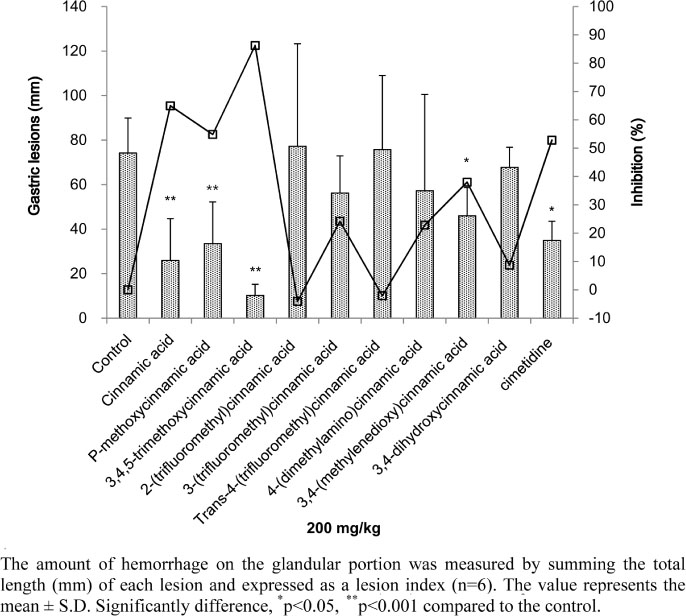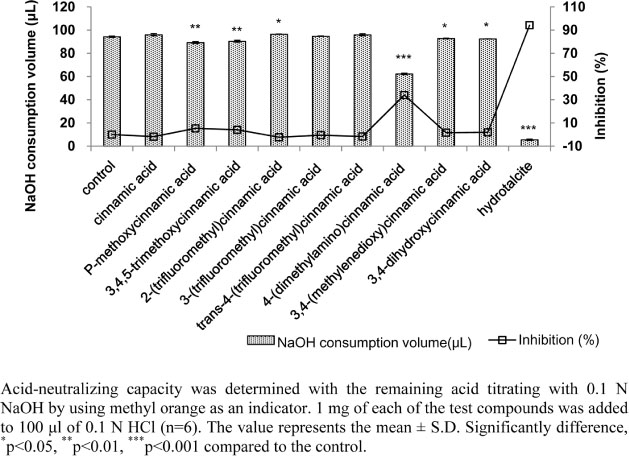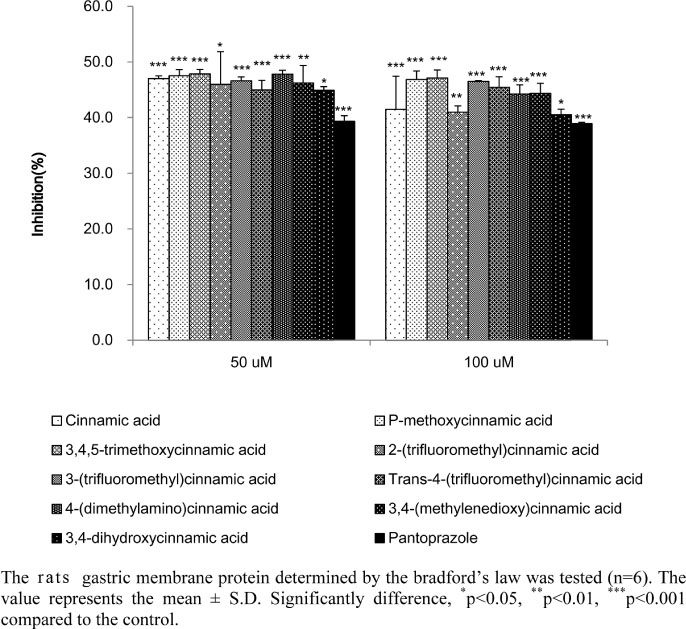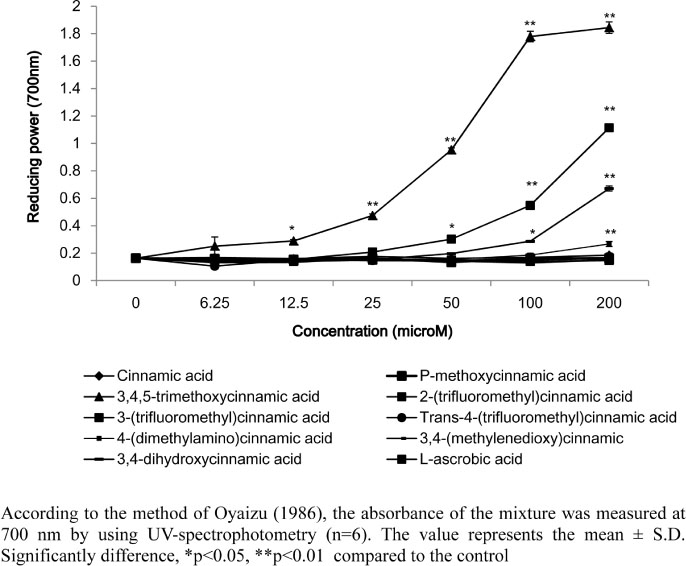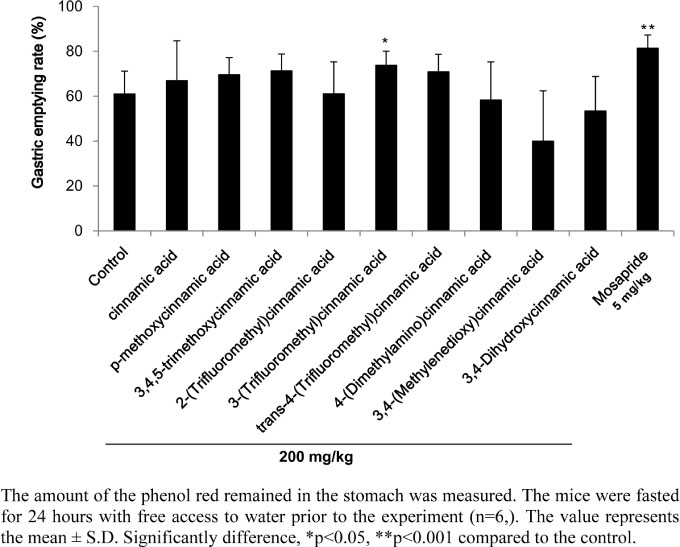Nat Prod Sci.
2017 Dec;23(4):299-305. 10.20307/nps.2017.23.4.299.
Protective Effects of Cinnamic Acid Derivatives on Gastric Lesion
- Affiliations
-
- 1College of Pharmacy, Duksung Women's University, Seoul 01369, Republic of Korea. choonsik@duksung.ac.kr
- KMID: 2401584
- DOI: http://doi.org/10.20307/nps.2017.23.4.299
Abstract
- P-methoxycinnamic acid and 3,4,5-trimethoxycinnamic acid are the compounds found in Polygalae Radix, the root of Polygala tenuifolia Willdenow, and have been reported to have hepatoprotective and anti-neurodegenerative effects. On the other hand, there are no reports of their effects on gastric lesions. This study examined the inhibitory effects of cinnamic acids, including p-methoxycinnamic acid, 3,4,5-trimethoxycinnamic acid, and 8 compounds (cinnamic acid, 2-(trifluoromethyl) cinnamic acid, 3-(trifluoromethyl) cinnamic acid, trans-4-(trifluoromethyl) cinnamic acid, 4-(dimethylamino) cinnamic acid, 3,4-(methylenedioxy) cinnamic acid and 3,4-dihydroxycinnamic acid), which were selected based on their presence in medicinal herbs and molecular weight, against gastric lesions. Animal models were used to confirm the protective effects on acute gastritis caused by the administration of HCl/EtOH. Gastric acid inhibition was examined by an acid-neutralizing test and the proton pump (Hâº/Kâº-ATPase) inhibiting activity. In addition, antioxidant tests were performed and the gastric emptying rate was determined. The results showed that cinnamic acid, p-methoxycinnamic acid, and 3,4,5-trimethoxycinnamic acid had an inhibitory effect on gastric lesions.
Keyword
MeSH Terms
Figure
Reference
-
1. Yakabi K, Nakamura T. Nihon Rinsho. 1998; 56:2336–2342.2. Laine L, Weinstein WM. Dig Dis Sci. 1988; 33:490–503.3. Rocha GA, Queiroz DM, Mendes EN, Barbosa AJ, Lima Júnior GF, Oliveira CA. Am J Gastroenterol. 1991; 86:1592–1595.4. Sachs G, Shin JM, Howden CW. Aliment Pharmacol Ther. 2006; 23:2–8.
Article5. Sohn YA, Hwang IY, Lee SY, Cho HS, Jeong CS. Biol Pharm Bull. 2017; 40:151–154.6. Morry J, Ngamcherdtrakul W, Yantasee W. Redox Biol. 2017; 11:240–253.7. Devasagayam TP, Tilak JC, Boloor KK, Sane KS, Ghaskadbi SS, Lele RD. J Assoc Physicians India. 2004; 52:794–804.8. Jung J, Lee JH, Bae KH, Jeong CS. Yakugaku Zasshi. 2011; 131:1103–1110.9. Mizui T, Doteuchi M. Jpn J Pharmacol. 1983; 33:939–945.10. Naik Y, Jayaram S, Harish Nayaka MA, Lakshman , Dharmesh SM. J Ethnopharmacol. 2007; 112:173–179.11. Lee EJ, Kim KS, Jung HY, Kim DH, Jang HD. Food Sci Biotechnol. 2005; 14:123–130.12. Oyaizu M. Jpn J Nutr. 1986; 44:307–315.13. Coruzzi G, Scarpignato C, Zappia L, Bertaccini G. Farmaco Prat. 1980; 35:466–472.14. Yen GC, Chen HY. J Agric Food Chem. 1995; 43:27–32.15. Kim M, Hwang IY, Lee JH, Son KH, Jeong CS, Jung JH. J Health Sci. 2011; 57:289–292.16. Koenig ML, Meyerhoff JL. Neurotox Res. 2003; 5:265–272.17. Hahm KB, Park IS, Kim YS, Kim JH, Cho SW, Lee SI, Youn JK. Free Radic Biol Med. 1997; 22:711–716.
- Full Text Links
- Actions
-
Cited
- CITED
-
- Close
- Share
- Similar articles
-
- Cinnamic acid derivatives as potential matrix metalloproteinase-9 inhibitors: molecular docking and dynamics simulations
- New antiepileptic drugs. II. Clinical use
- Effects of cinnamic acid on memory deficits and brain oxidative stress in streptozotocin-induced diabetic mice
- A Case of Pigmented Contact Dermatitis Caused by Cinnamic Aldehydes
- A Case of Allergic Contact Dermatitis due to Propolis Tincture

